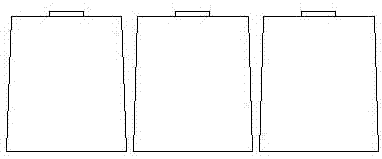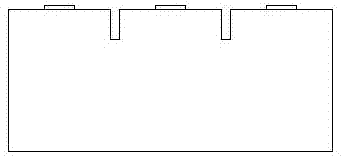Manufacturing method for improving uniwafer output of light emitting diode
A technology of light-emitting diodes and manufacturing methods, which is applied in semiconductor/solid-state device manufacturing, electrical components, circuits, etc., can solve the problems of reducing single-chip output, long production cycle, and high equipment cost, and achieve positive collapse and leakage improvement. Low cost, improve the effect of single chip output
- Summary
- Abstract
- Description
- Claims
- Application Information
AI Technical Summary
Problems solved by technology
Method used
Image
Examples
Embodiment 1
[0041] 1) The distributed Bragg reflection layer, the N-type confinement layer, the active layer, the P-type confinement layer, and the window layer are epitaxially formed sequentially on the GaAs substrate.
[0042] 2) Use a new chromium plate with the same product name as the photolithographic plate with a core size 5 μm smaller than that of the conventional production process to make core grains and P electrode patterns on the window layer.
[0043] 3) An N electrode is formed on the bottom surface of the substrate to form an LED chip.
[0044] 4) Use a diamond blade with a thickness of 5 μm to half-cut the front of the LED chip. The knife speed is 10 mm / s, and the depth of the formed front cutting line is 10 μm, and the width is 5.2 μm. Each chip is cut. Pure water is used as cooling water during cutting, the temperature is 15°C, and the temperature fluctuation range does not exceed ±1°C.
[0045] The results obtained are as image 3 shown.
[0046] 5) Unload the film and...
Embodiment 2
[0060] 1) A distributed Bragg reflection layer, an N-type confinement layer, an active layer, a P-type confinement layer, and a window layer are sequentially formed on the GaP substrate.
[0061] 2) Using a new chromium plate with the same product name as the conventional production process, the core grain size of the photolithography plate is 10 μm smaller, and the core grain and P electrode pattern are made on the window layer.
[0062] 3) An N electrode is formed on the bottom surface of the substrate to form an LED chip.
[0063] 4) Use ICP dry etching to photocut a dicing line on the front of the LED chip to obtain a front dicing line with a width of 20.3 μm and a depth of 50 μm.
[0064] The results obtained are as image 3 shown.
[0065] 5) Unload the film and test the photoelectric parameters.
[0066] 6) Use a lithography machine with upper and lower CCD lenses to photocut a 30 μm wide and back-cutting aisle on the back of the LED chip corresponding to the front-s...
Embodiment 3
[0078] 1) A distributed Bragg reflection layer, an N-type confinement layer, an active layer, a P-type confinement layer, and a window layer are sequentially formed on the GaP substrate.
[0079] 2) Using a new chromium plate with the same product name as the conventional production process, the core grain size of the photolithography plate is 20 μm smaller, and the core grain and P electrode pattern are made on the window layer.
[0080] 3) An N electrode is formed on the bottom surface of the substrate to form an LED chip.
[0081] 4) Use a laser cutting machine to half-cut the front side of the LED chip, forming a front side cut line with a depth of 80 μm and a width of 30.1 μm.
[0082] The results obtained are as image 3 shown.
[0083] 5) Unload the film and test the photoelectric parameters.
[0084] 6) Using a photolithography machine with upper and lower CCD lenses, photocut a backside cutting track with a width of 60 μm on the back of the LED chip corresponding t...
PUM
| Property | Measurement | Unit |
|---|---|---|
| Depth | aaaaa | aaaaa |
| Thickness | aaaaa | aaaaa |
| Thickness | aaaaa | aaaaa |
Abstract
Description
Claims
Application Information
 Login to View More
Login to View More - R&D
- Intellectual Property
- Life Sciences
- Materials
- Tech Scout
- Unparalleled Data Quality
- Higher Quality Content
- 60% Fewer Hallucinations
Browse by: Latest US Patents, China's latest patents, Technical Efficacy Thesaurus, Application Domain, Technology Topic, Popular Technical Reports.
© 2025 PatSnap. All rights reserved.Legal|Privacy policy|Modern Slavery Act Transparency Statement|Sitemap|About US| Contact US: help@patsnap.com



